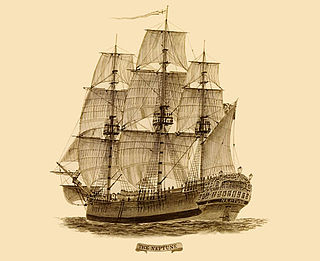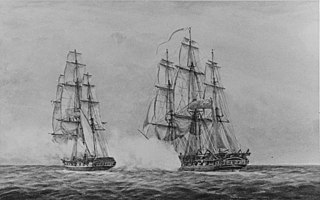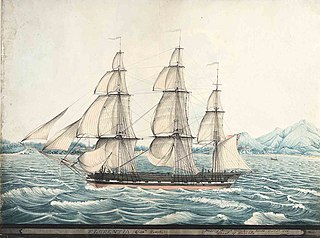Gallery
- HMS Pitt
- Merchantman of similar age to Kitty; Table Mountain is in the background
- An EastIndiaman similar to Royal Admiral
The fourth Fleet is an unofficial term for the flow of convict ships from England to Australia in 1792. [1] The term was coined by C.J. Smee, a historian, who has catalogued the genealogies of the First, Second and Third Fleet convicts and who used the term to group those ships that followed in the months immediately after the Third Fleet. [2]
The ships connected to the "fleet" are:
The Second Fleet was a convoy of six ships carrying settlers, convicts and supplies to Sydney Cove, Australia in 1789. It followed the First Fleet which established European settlement in Australia in the previous year.
The Third Fleet comprised 11 ships that set sail from the Kingdom of Great Britain in February, March and April 1791, bound for the Sydney penal settlement, with more than 2,000 convicts aboard. The passengers comprised convicts, military personnel and notable people sent to fill high positions in the colony. More important for the fledgling colony was that the ships also carried provisions.

A convict ship was any ship engaged on a voyage to carry convicted felons under sentence of penal transportation from their place of conviction to their place of exile.
Events from the year 1796 in Ireland.
Charles Bateson was a maritime historian, journalist and author.
Queen was a three-decker sailing ship built in 1773 at Georgia in the United States.
Matilda was a ship built in France and launched in 1779. She became a whaling ship for the British company Camden, Calvert and King, making a whaling voyage while under the command of Matthew Weatherhead to New South Wales and the Pacific in 1790.
Kitty was a merchantman built at Sunderland in 1787. In 1790 she carried slaves from the Gold Coast to Jamaica. Then in 1791 she transported convicts and goods from England to Australia. She was last listed in 1805.
Emu was a merchant ship built at Liverpool in 1812 that transported convicts to Australia. An American privateer captured her in 1812 as she was carrying female convicts to Van Diemen's Land.

Holkar was an American privateer active during the War of 1812 that made several captures. HMS Orpheus destroyed her on 11 May 1813.
Friends was a 339-ton merchant ship and convict ship that transported convicts to Australia. She plied the Caribbean trade routes.
Warrior was an American privateer.

Michael Hogan (1766–1833) was an Irish-born shipowner involved in the early settlement of Australia.
Earl Grey was a merchant ship built at Newcastle upon Tyne, England in 1835. She made four voyages transporting convicts from Great Britain to Australia.
Burrell was a merchant ship built at Newcastle in 1825. She made two voyages transporting convicts from England to Australia.
Currency Lass was a 90-ton schooner, built in 1826 at Paterson Plains, New South Wales, Australia for Thomas Winder & others.
New York Packet was a 270-ton merchant ship built at Bristol, England in 1823. She made one voyage transporting convicts from Tasmania to Sydney.
Royal Sovereign was a 336-ton merchant ship built at Whitby, England in 1829. She made one voyage transporting convicts from England to Australia and one voyage from Ireland to Australia.

Florentia was a 453-ton merchant ship built at Newcastle upon Tyne, England in 1821. She made one voyage transporting convicts from England to Australia and one voyage from Ireland to Australia. She made three voyages for the British East India Company (EIC).
Eden was a 513-ton merchant ship built upon the Thames River, England in 1826. She made two voyages transporting convicts from England to Australia.